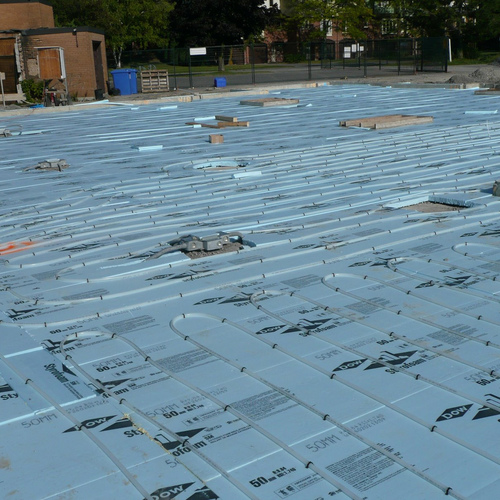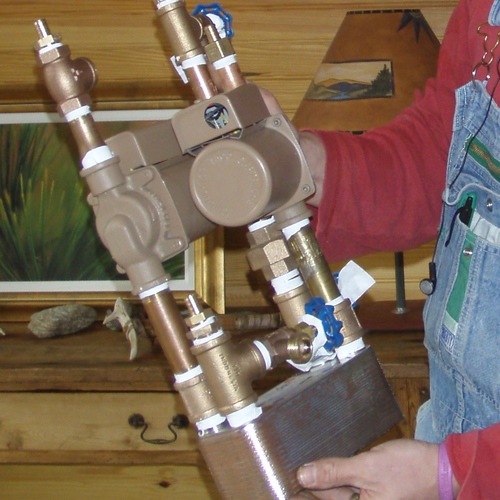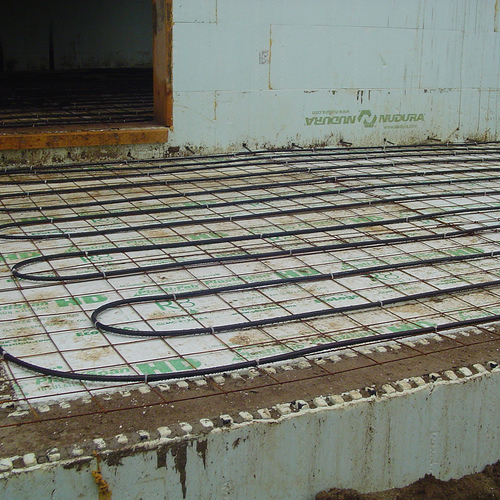
Image Credit: Christopher Clapp/Fine Homebuilding magazine
Matt Cooper’s 1,800-square-foot woodworking shop sits on a 6-inch concrete slab heated with a radiant-floor system. Unfortunately, the on-demand water heater that Cooper uses to heats the water for the in-slab tubing isn’t performing well.
“I’ve been using a Takagi Jr. to heat it for the past couple of years but it’s been no end of headaches,” Cooper writes in a Q&A post at Green Building Advisor.
“I’d like to figure out a better way to heat the water,” he says, “probably a direct-vent system so that the wood dust doesn’t create problems with the burner (just one part of the TK Jr. issues). It seems that my options are either a better version of the current on-demand hot water heater/boiler, or a tank-style water heater.”
The building and the slab seem to be well insulated, but Cooper’s hot-water options are limited to propane (at $2.25 per gal.) and electricity (12 cents a kWh).
Cooper’s options are the topic for this Q&A Spotlight. (Neil B. posted a similar question about heating a workshop elsewhere on the Q&A Forum.)
Tank-style heaters are simple and reliable
A.J. Builder recommends a tank-style water heater for Cooper’s system. “Tank units rarely have issues,” he writes. “Simple installs available from manufacturer.” He says he’s dealt with similar heating systems for decades, and would recommend installing the water heater in a dust-free utility closet.
“Standard tank units are bullet- and idiot-proof,” Builder writes. “I just installed an [A.O.] Smith 50 that cost $1,000 to the customer. PVC vent and intake. Four hours — done.”
Other suggestions from A.J. Builder include turning down the thermostat, burning wood pellets if he needs a cheaper fuel, or raising his prices.
Woodworking shops are…
Weekly Newsletter
Get building science and energy efficiency advice, plus special offers, in your inbox.

This article is only available to GBA Prime Members
Sign up for a free trial and get instant access to this article as well as GBA’s complete library of premium articles and construction details.
Start Free TrialAlready a member? Log in















9 Comments
solar box
pre-heat the water through a black solar box and black coils placed in direct sunlight.
Where'd you get that illustration?
We are required to put continuous R-10 under our heated slabs, and I've never seen anyone sculpt their gravel base with that nifty transition from 1" to 2" insulation thickness. The welded wire fabric looks good where it's drawn, but I've always seen it laying flat on the ground, never up on chairs or other supports, so you're depending on the slab finishers to somehow pull it up to mid-slab as they walk on it (yes, I know, some concrete rakes have a little nub on them specifically for pulling the mesh up). I prefer #4 rebar on 1-1/2" dobies. And I guess Martin didn't get his way on this one, with the vapor barrier under the insulation.
Response to David Meiland
David,
Scott chose to illustrate this Q&A Spotlight with an old illustration from Fine Homebuilding. You are quite right to point out that the illustration is showing its age.
We can't afford to draw up a new detail every time we publish an article, unfortunately. Your points are valid; thanks for making them.
30,000 BTU/hr,not 23,600 BTU/hr: Real designs need real math.
An EF of 0.62 doesn't not mean it'll get 62% efficiency in a space heating app.
When used for space heating the duty cycle of the burner is an order of magnitude higher than serving up the 63-odd gallons of hot water in an EF test. The steady state thermal efficiency (at 100% duty-cycle) of non-condensing tank heaters is right around 80%, not 62%, and at space-heating type duty-cycles you'll get pretty close to that steady state number, and certainly not any less than 78%.
The difference in the stated output number is more than 25% bigger, which is a big enough difference that it really needs to be factored into any real system design.
The financial math chucking a system that can be re-commissioned to function optimally for something like ~$500 don't favor buying a new tank heater, condensing or otherwise.
Designing a radiant slab heating system around a non-condensing tank HW has some real issues to be considered too, if you want the thing to last. A water heater like that is NOT designed to be operated at continuous flow with the low-low return water temperatures you will get from a radiant slab. Under those conditions the heat exchanger sees copious levels of destructive condensation, severely shortening it's life. While that's fixable with radiation bypass plumbing or other standard hydronic designer tricks of the trade, it's absolutely essential to get it right, or you'll be back at square one in short years. For those unwilling/unable to do the math and design enough hooks into the plumbing to protect it, and do the requisite system measuring/tweaking/commissioning, the State GS6-40-HBDS or similar would be a TERRIBLE choice for a slab radiant system.
Finned copper water tube heat exchangers like that of the Takagi Jr. are much more tolerant of continuous low temp incoming water, which is why most swimming pool heaters use that type of heat exchanger, and why purveyors of one-size-fits-all slab radiant heating systems go that route. If only they didn't abuse it in other ways it works out just fine, which is why simply fixing the deficiencies of the current system is probably the right way to go.
Of course CONDENSING hot water heaters (like the Vertex) get their efficiency out of that condensation that comes with low return water temps, capitalizing on the very factor that would damage the non-condensing tank. That makes it far the better/safer choice for hydronic-hack designers, but a big chunk of change compared to fixing the Takagi-Jr. based system.
Reply to Dana Dorsett
I certainly cannot contest your calling me a hydronic-hack designer. I've been tinkering with these systems for a couple decades as a plumber and builder but I'm not an engineer. I do have to wonder about your characterization of a tank used in this fashion as a continuous duty cycle or the return temp as low-low.
I have several of the direct vent state water heaters I mentioned out there still heating floors and producing domestic hot water after fifteen years or more. The return water is generally around 70 degrees and it is being mixed with the return water from the floor loop to supply 90 degree water to the floor so the flow rate is generally very low and the duty cycle is not continuous in that the the flame is not burning more than once every twenty minutes or so in the relatively low energy use passive solar homes they are installed in here in North Carolina. Of course It would be a different story if a system like this was used for driveway snow melt or for heating a large and drafty building.
During the DOE combined heat and hot water meeting at the 2010 Westford Symposium, Martin Thomas from Natural Resources Canada outlined many of the problems they were having with trying to force modulating tankless water heaters .to serve for space heating. Some in the discussion had recorded service efficiencies of as low as 50% and I have seen excessive soot accumulation in the heat exchangers with extended low burn rates.
I guess another approach rather than suggest a different water heating device would be to ask what is causing the trouble with the existing tankless unit. How would you propose to spend $500 to fix the problem he is currently having with making his tankless unit play nice with his radiant floor?
It's still a real hydronic design problem.
There are plenty of hydronic hacker hobbiests out there- you can count me among their number.
I have only done one combi-heating system based on a tankless HW heater, but it's been operating pretty cleanly without problems since commissioning it in 2008. It still hits it's raw combustion efficiency numbers, and has had zero problems- the only maintenance so far being cleaning the filter. It's not heating a slab though- it's a multi/micro-zoned system with diverse radiation from plated sub-floor radiant to cast-iron rads to a hydro-air coil, all set up to run at 125-130F water temp. The tankless is slaved to the aquasat on a 48 gallon buffer tank set to 130F, and all radiation sips from the tank. Domestic hot water is drawn though a heat exchanger inside the buffer tank. If a slab zone were added it would need a mixer valve on that loop, but it would not change the operating characteristics of the tankless, which is set up with ~2gpm flow and 158 output, so it modulates the fire up ~75K BTU/hr when the return water in the bottom of the tank drops with multiple zones calling for heat during big hot water draws, but finishes at ~28KBTU/hr when the aquastat on the buffer is satisfied, which is about the 1/5 point of it's firing range. Design heat load on that place is about 36-38K, the air handler coil will draw over 40K all by itself, but they never run out of hot water or heat. It's kludgy, but it works, and was designed for the specific loads & radiation. A condensing Vertex would have been cheaper/easier, but would have had capacity issues under the highest concurrent loads. It was a much messier design problem than space-heating only on a single-zone slab, but it allowed micro-zoning the system without short cycling the thing into an early grave.
Pumping rates matter on the non-condensing tanks too. At sufficiently low pumping volumes you can get there direct-pumping the water heater without ending up destroying the heat exchanger with condensation. It's best to actually design it, but sometimes dumb luck gets you there too- if it works, don't change it. If it's only doing 3 burns an hour at a 10-60% duty cycle that's a lot more ignition cycles than the equipment was designed for, but that's also comparatively cheap to fix should the ignition components fail. But there are numerous examples of folks in New England where counting on dumb-luck on non-condensing tank based slab-heating systems hasn't worked out so well, usually a function of pumping rates and duty cycles that are too high resulting in condensation problems.
With Matt Cooper's existing tankless system if the pumping rates and delta-Ts are at all reasonable he may be able to just install the $55 direct-vent kit and some cheap tin duct to bring in the combustion air and call it done for under $100. But it may need tweaking to run optimally. If optimizing his system involves installing different pumps it might end up closer to $500, but probably not more than that. Without knowing the full extent of what's there it's hard to say, but simply yarding out the tankless and plumbing a tank in it's stead without doing any sort of design assessment/adjustment would be risky.
We don't really know what sins of omission/commission are on his system. Most of the internet vendor systems are plumbed primary/secondary with separate pumps and more often than not over-pumped on the tankless loop resulting in a low a delta-T on the tankless and a relatively (and unnecessarily) high-fire on the burner, and almost never set up to modulate with load. Some are pumped direct into god-knows-what amount of pumping head to the radiation with fingers crossed- there are all sorts of hacks out there that should never have been offered as a product for sale that kinda-work, but not optimally.
Doing a sort of real heat load calculation is the first part, then setting up the flows on both the primary and secondary loops so that the tankless delivers the design condition amount of heat at delta-T of between 25-75F at a flow of 2-3gmp on the tankless end is generally pretty nice to the tankless, and even if it only modulates within a narrow range, matching the output to the actual peak loads will result in fewer ignition cycles.
Forgot to mention...
... an 1800' shop building located near Ithaca NY where the 99% outside design temp is 0F could easily have a heat load in excess of the ~30,000 BTU/hr full burner output of State GS6-40-HBDS direct vented non-condensing hot water heater.
But the heat load is unlikely to be even half the full-output of the TK-Jr.
Design temps for NC are 15-25F warmer than that, and heat loads of houses designed for passive solar are probably going to be well under those of a code-min or even better-than-code shop building in upstate NY. The right solution for one is unlikely to have a close resemblance to the right solution for the other.
I'm guessing the peak heat loads of the NC solar homes are under 15K (half the full output of the State water heater), which means the flow & turbulence inside the tank less- under under 1gpm of flow in the tank at 50F delta-T between return water & setpoint. That very low flow /low turbulence delivers a lower risk of condensation than when trying to pull the full 30K out of it, which CAN be done, but at more than 1gpm, which delivers a lot more turbulence (= higher condensation risk.) With near-tank bypass to keep the return water above 120F, and setting the tank to 140F or even higher you can get there without destroying it, but it's a more complicated design.
Tankless to Air Handler Combination
BSC's research (headed up by Armin Rudd) has primarily looked at connecting a tankless water heater to a fancoil (air handler) forced air system. He added a small storage tank as a buffer, which should reduce short cycling issues. Not sure if it is the right solution here, but I thought I'd bring it in to the discussion. RR-1206: Measure Guideline–Combination Forced-Air Space and Tankless Domestic Hot Water Heating Systems http://www.buildingscience.com/documents/reports/rr-1206-measure-guideline-combination-forced-air-space-tankless-domestic-hot-water-heating-systems/view?searchterm=tankless. John Siegenthaler pushes the use of buffer tanks with low-mass condensing boilers, when connected to low-load houses, to address short cycling issues--for instance, in a 2011 JLC article Hydronic Heating for Low-Load Houses http://www.jlconline.com/hvac/hydronic-heating-for-low-load-houses.aspx
Response to Kohta Ueno
The buffer tank in the BSC study should only be necessary to reduce the short-cycles from domestic hot water draws and provide more even water temperatures at the tap. It looks like they're over-pumping it with a Taco-009 as if it were some truly high-head loop. (I'd like to see their math on that one!) With an air handler as the only heat emitter that wouldn't be unnecessary. With a radiant slab the thermal mass of the slab is many 10s of times greater than that of the ~85lbs of water in the 10 gallon buffer. Only with low-output low mass radiation or micro-zoned mid-mass systems would ever result in short cycling on the space heating end.
The gunk/clogging and corrosion issues with that setup are due to the fact that they're running potable water in the radiation rather than running it as a closed system. That doesn't happen in Matt Cooper's heating-only closed loop application, or the kludge I designed around a tankless since it's only running "dead" heating system water in the In a closed system, with no new minarals or oxygen entering the system daily. In closed systems there is no need for an expensive bronze or stainless-impeller pump either.
Siegenthaler's approach is somewhat overkill- it's much cheaper to do the same thing using a plate heat exchanger isolated heating system using a condensing hot water heater as the buffering mass as well as the potable hot water source. But since it requires two pump you'd be at 100-120watts of pumping power rather than his 30w ECM drive pump. But at the duty cycles it's running on low-load house it's hard to rationalize the additional cost of the pumps just so save 100kwh/year. At the current cost of rooftop photovoltaic solar making up the difference in power use with a partial-panel of PV is cheaper than the single ECM drive pumped system. Yes, the high mass Versa Hydro with an ECM pumped system is a marvel of efficiency, but there's some cost-optimization that could be factored in too. For a small hit in efficiency you can get there with a Polaris or Vertex. He finishes with:
"There are many other system configurations that would be suitable for low-load houses. Most of them will embody several of the desirable characteristics described earlier. The goal in designing any of these systems is to leverage the inherent advantages of the newest technology while keeping the system as simple as possible."
TESTIFY, brother Siggy!
Log in or become a member to post a comment.
Sign up Log in